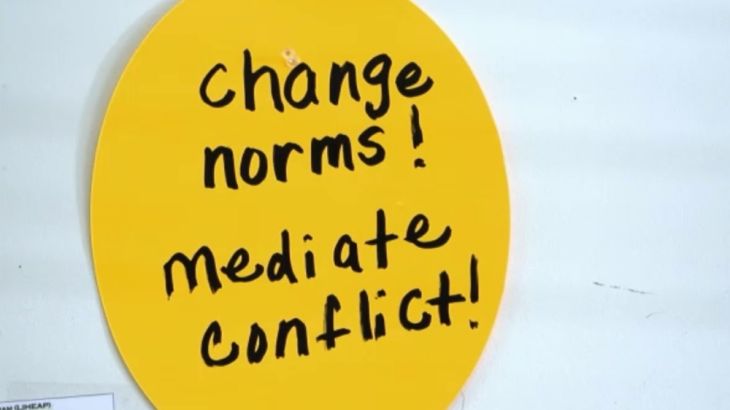Is gun violence in the US infectious?
When an epidemiologist studied maps of shootings in Chicago, the pattern resembled the spread of infectious diseases.

Chico Tillmon remembers the first time he saw a dead man.
“I was eight years old, and my mum had sent me to the mailbox. As I approached, I saw a guy being robbed for his Boombox. And the guy was killed right in front of me. I saw a man lying next to the mailbox dead.”
Keep reading
list of 4 itemsIsraeli settlers set fire to cars, homes of Palestinians under occupation
Gunmen kill at least 11 in two attacks in Pakistan’s Balochistan
A knotty question of parent liability in the Crumbley school shooting case
It wasn’t his last. Between when he was 17 and 22, nearly 50 of his friends were shot and killed. “At some point,” he says, “it became normal.”
Chico’s story isn’t unusual in his community of Austin, one of Chicago’s predominantly African-American, low-income neighbourhoods. Like his peers, after a childhood spent witnessing violence, he became a perpetrator of it himself. He went on to spend 16 years in federal prison for gang-related activity.
“I was taught to respond to aggression more aggressively,” he says. “If the person was bigger than me, pick something up and hit them. And as I got older, it went from picking up a stick to fight somebody bigger, to picking up a gun.”
Law enforcement, educators, politicians and community representatives have struggled for decades to agree on an effective and sustainable solution to the seemingly never-ending cycle of gun violence that disfigures communities such as Chico’s.
Dr Gary Slutkin never set out to solve that problem. An epidemiologist by training, he spent the first decade of his career working across the African continent to eradicate contagious diseases. But after returning to the US, burned out by the trauma that he’d seen, he found himself in the midst of another epidemic.
“I started to do what we do in science,” Slutkin recalls. “We say: ‘let’s look at the charts, let’s look at the graphs, let’s look at the maps, let’s look at the data.’ It’s just like a patient.”
Slutkin noticed striking parallels between gun violence and contagious diseases. Studying maps of Chicago that showed where shootings had recently occurred, he found clustering, a term scientists use to describe how epidemics are transmitted among people in a geographically small area, often then being spread by individuals from the original site of the outbreak to other locations. He found that a map of shootings over a particular period in Chicago could bear a striking resemblance to a map of Aids cases in rural Uganda.
When he connected the dots, he said, the relationship became clear: “This violence had fulfilled the criteria of the population characteristics of a contagious disease.”
READ MORE: What are the roots of gun culture in the US?
With the help of the School of Public Health at the University of Illinois in Chicago, Slutkin founded his own NGO, Cure Violence. He recruited staff from Chicago’s most violent neighbourhoods, many of whom had their own histories with gun violence, to act as ‘violence interrupters’.
In 2011, Chico was out of prison and looking to turn his life around. He became involved in Cure Violence, and found that his own experience of violence, and his strong relationship with his neighbours, meant they trusted him to help them to make a change.
Chico became a violence interrupter in one of Cure Violence’s programmes. In the same way that a health worker engages with a community to persuade individuals to change their habits and reduce transmission of disease, violence interrupters put themselves in potentially violent scenarios, from street corners to Emergency Rooms, and persuade people involved in disagreements to not use violence as a way of solving problems or seeking retribution.
“One of the components that Cure Violence taught me is that I have to show people I care,” he explains. “So I rebuilt those relationships and spent time with those high-risk individuals on a daily basis, so that when they got into a conflict, they didn’t second-guess me. And then when a conflict was about to happen, when I spoke to them, I was able to get them to put down the guns.”
Slutkin’s theory is borne out in Cure Violence’s swift and significant results: a 2012-2013 study showed that the Chicago neighbourhoods where it operates saw incidences of shootings drop by 41 to 73 percent. His approach has now gone global, with affiliate programmes in New York City, Cape Town and Jerusalem.
OPINION: Gun control in the US is not a fantasy
Chico says his work with Cure Violence has given him the confidence to plan for the future. “For the first time, I could be proud telling people how I earned a living.”
Today, he is a programme manager for Cure Violence in Chicago, and an evangelical minister. He’s also working towards a PhD from the University of Illinois at Chicago.
“Back then, to me, making it alive to 25 was a big deal. But working with Cure Violence, it not only saved other people’s lives – it helped me save my own life, too.”